
Teamwork is critical for the success and effectiveness of an organization. An ambitious team is built on open communication, shared goals, and clearly defined roles.
However, only very few managers are confident that their staff understands the company’s strategy, objectives, and direction.
Your employees would need to work as a team to meet the company’s goals.
This article contains very interesting teamwork statistics to assist you in providing an efficient environment for the workers and propelling your business forward.
You will also learn the latest trends in effective team collaboration and team building to help encourage efficient teamwork.
Teamwork Vs. Collaboration
The concepts of teamwork and collaboration seem the same because people often use them interchangeably.
Both terms mean the same thing to most people because they involve people working together to achieve a common goal.
However, most employers differentiate them and request a job candidate should either have teamwork skills, collaboration skills, or both.
The truth is that teamwork and collaboration are different, although they look very similar. Collaboration is a result of teamwork.
People who work collaboratively complete tasks collectively, while teamwork incorporates the individual contributions of all team members to achieve a goal.
Collaborators work as equals, usually without managers, to generate ideas or make decisions to achieve a goal.
Whereas a team leader typically oversees teamwork, and team members are assigned individual tasks to complete to contribute to the team’s overall goal.
However, the best method for effective employee performance is collaborative teamwork.
With the right leadership, collaborative teamwork helps achieve goals more efficiently by distributing work equally and delegating tasks to those with the most appropriate skill set.
Working in a team can increase employee engagement and motivation.
Useful Teamwork and Workplace Collaboration Statistics To Know
1. About 75% of employers agree that teamwork and collaboration are essential in the workplace. (source)
2. 86% of business leaders say that a lack of collaborative teamwork is the reason for failure in the workplace. (source)
3. Effective communication and collaboration affect the upshot of a business due to the level of trust, retention, engagement, and productivity it gets. (source)
4. Most companies that utilize teamwork and collaboration in a workplace are 5× better than companies that don’t. (source)
5. The revenue of the collaboration software market has been predicted to increase continuously between 2023 and 2028 by 10.4%. (source)
6. Despite working remotely, most U.S. workers say that their jobs rely on in-person (physical) collaboration. (source)
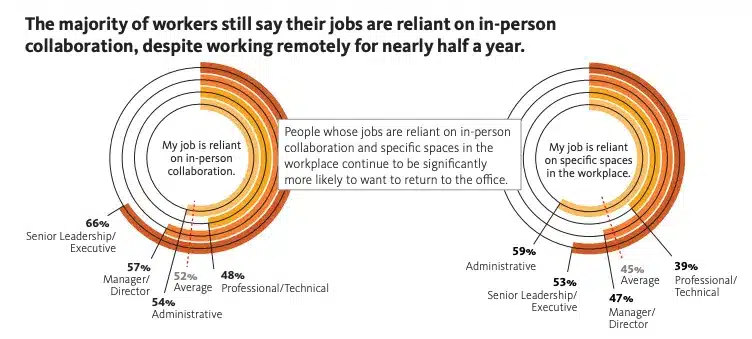
7. 49% of surveyed U.S. workers say that collaborating in the office is easier than collaborating at home. This is higher than the 15% of workers who say collaborating at home is easier. (source)
8. About 30% of improvements in the performance of employees are simply because of the information they got in collaboration with other staff. (source)
9. Teamwork and collaboration in the workplace have been said to increase sales by 27%. (source)
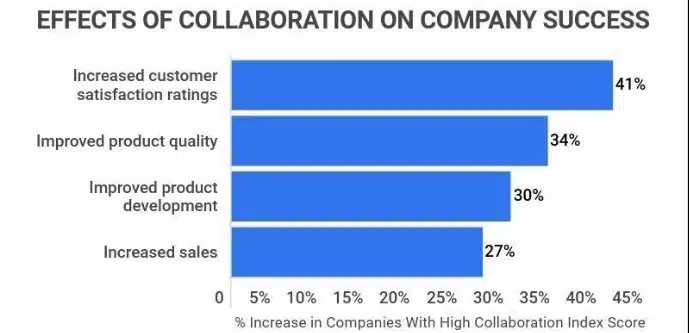
10. 28% of marketers have observed that collaboration while conducting marketing activities is one of the best ways to gain visibility. (source)
11. According to Forbes, collaboration is listed as one of the top 5 skills every worker should have to succeed at work. (source)
12. The global enterprise collaboration market was valued at $54.50 billion in 2023. However, it is expected to rise to $90.60 billion by 2028 at a CAGR of 10.7%. This growth is due mainly to increased online tools or mobile devices for collaboration. (source)
13. About 83% of employers claim using technology for effective collaboration. (source)
Most employees believe that collaboration technologies aid teamwork. These technologies include:
- Conference meeting tools — shared whiteboards, community forums, and videoconferencing tools/software.
- Communication tools — Instant messaging, emails, and group video calls.
- Coordination/organization tools — digital calendars and project management apps.
14. Over 1,500 companies have incorporated human intelligence–AI collaboration in their projects. (source)
15. 94% of companies say they want to adopt a cognitive collaboration (Human intelligence + AI) solution for their workers. (source)
16. 91.1% of employees claim they would like to be a part of any organization that cultivates honest communication and collaboration. (source)
17. 97% of employees and employers alike believe that the lack of teamwork within an organization will affect the overall outcome. (source)
Statistics on the Importance & Benefits of Effective Teamwork Collaboration
18. Effective teamwork is crucial for an employee’s well-being. (source)
19. Teamwork accounts for lower employee burnout. It reduces exhaustion for 60% of workers due to its emotional support. (source)
20. Teamwork provides awareness for 41% of employees. It helps them recognize their strengths and weaknesses while reducing absenteeism and increasing their activeness at the workplace. (source)
21. According to Forrester, effective team collaboration platforms improve productivity by 10%. Effective collaboration platforms allow employees to save about 5-10% of their work time and reduce work stress. This is one huge benefit of teamwork and collaboration. (source)
22. Effective communication and collaboration generate 4.5× higher talent retention. (source)
23. A report shows that workers are 13% more productive when happy. Workers tend to be happier at work when the environment is friendlier, and the workload is less stressful. Effective teamwork and collaboration make the workload very easy. (source)
24. Employees have noticed a 72% increase in productivity, a 63% increase in customer service, and a 60% employee confidence due to effective communication and collaboration. (source)
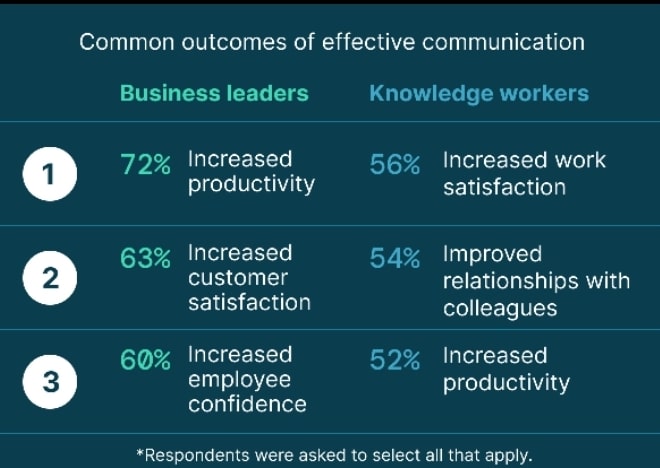
25. Teamwork and collaboration create an open environment for workers, bringing about 17% more productivity. (source)
26. Happy employees increase their performance by more than 20% compared to unhappy employees. (source)
Statistics On Teamwork and Collaboration Issues in the Workplace
27. Workload causes over 36% of employee-related stress. Team dynamics affect over 92% of the factors that cause employee stress. (source)
28. About 16% of remote workers cite difficulties in collaboration and communication as one of their biggest challenges. (source)
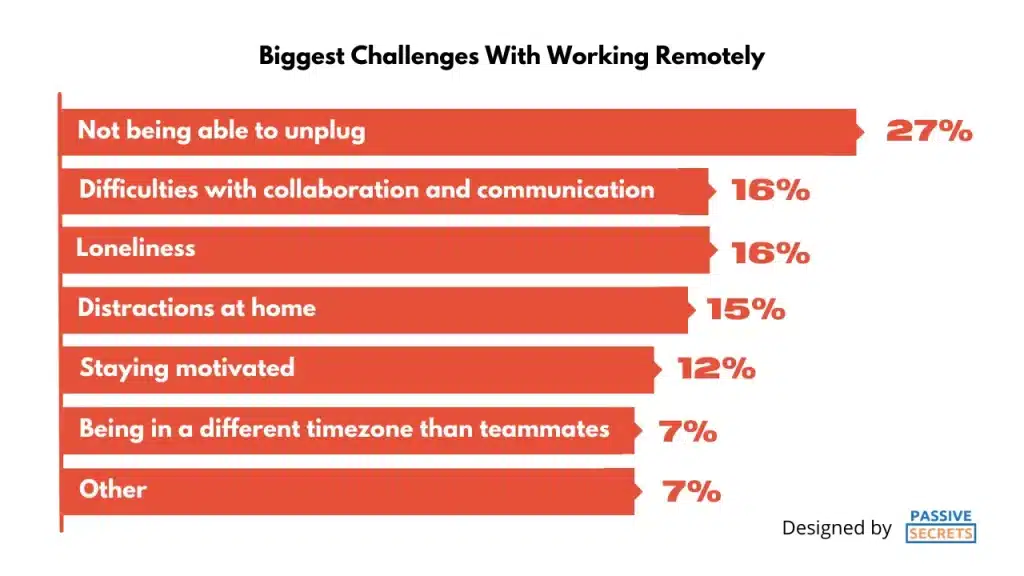
29. 28% of employees (teams) say that miscommunication is one of the causes of missed deadlines. (source)
30. 97% of business executives and employees feel that lack of alignment within a team significantly impacts project or task results. (source)
31. Teamwork and collaboration in workplaces pose some problems for employees, such as skill overlap, reduced engagement, and harmful interior competition. Hence, management needs to do a careful assessment to ensure these problems are checked. (source)
32. 41% of respondents say it is more challenging to work with other departments (cross-functionally) than with other teams in their departments. (source)
33. 75% of business executives report that their business functions (units) compete against each other rather than collaborating on digital projects. This shows that most companies do not understand the importance of digital collaboration. (source)
34. Feelings of employee isolation tend to reduce the level of productivity in a workplace by 21%. (source)
35. Almost 36% of 1000 surveyed U.S. employees say they don’t personally keep track of their team goals. (source)
36. About 53% of surveyed U.S. employees say they have partial to zero visibility into other teams’ goals. (source)
Online Collaboration and Teamwork Statistics
37. 76% of the global workforce uses videoconferencing as part of their remote working tools. (source)
38. 86% of younger employees (between the ages of 25 and 34) prefer to use video conferencing tools for online teamwork. This is a higher percentage than 46% of older employees (55+) who use the tools. The younger generation seems more inclined toward using online tools to aid collaboration. (source)
39. About 60% of younger employees effectively use at least three online tools to collaborate with their colleagues. (source)
40. Between 2019 and 2021, there was a 44% increase in the use of collaboration tools for work. (source)
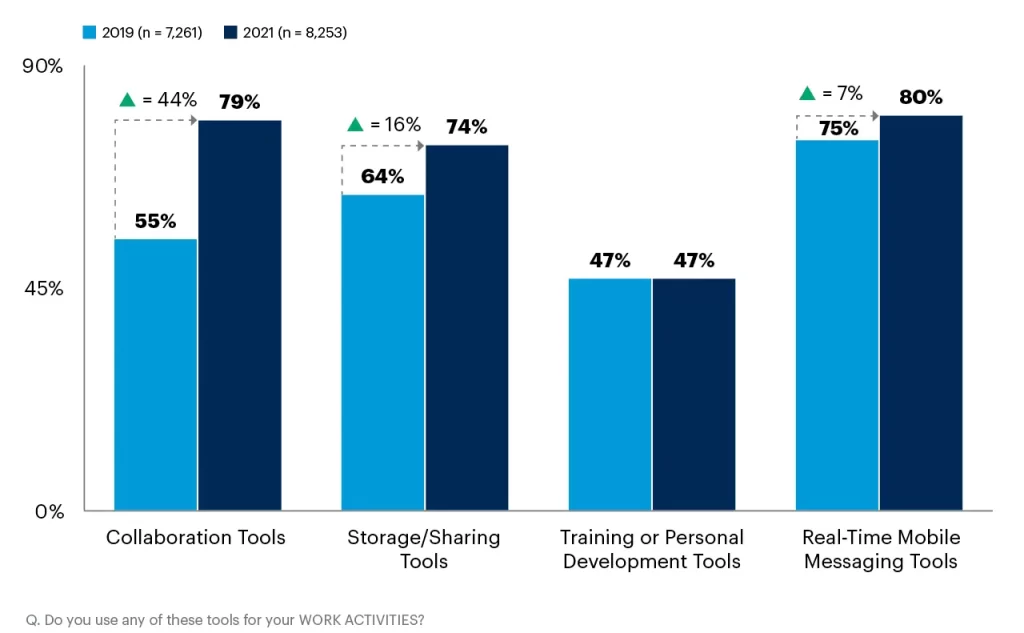
41. Before the COVID-19 pandemic, workers in the U.S. spent about 43% of their work time collaborating online or in person. However, the percentage fell to 27% during the pandemic. This shows that employees tend to work individually when working from home. (source)
42. The global collaboration software market size is expected to increase to $17.9 billion by 2025. (source)
43. The team collaboration software market will be worth $24.2 billion by 2027. (source)
44. In 2020, Zoom was the most used online tool for remote team collaboration in the U.S. Over 36% of workers used the online tool for conference meetings. (source)
45. In May 2020, there was a 176% increase in the installation of enterprise collaboration apps. The number is rapidly increasing as the rate of remote jobs is increasing. (source)
46. According to a Slack report, over 600,000 companies used Slack’s team messaging in 2019, report to improve communication in team collaboration. (source)
47. Additionally, a VVenture Beat report shows that over 500,000 companies used Microsoft Teams as a collaboration tool in 2019. (source)
Individual Work Vs. Teamwork Statistics
48. Companies lose about $450 billion – $550 billion yearly to disengaged or isolated employees. Most employees are not engaged in their jobs. (source)
49. The feeling of isolation can gradually reduce an employee’s performance by 21%. (source)
This shows that working as a team is better than isolating or working as a single individual, as the latter can reduce performance and productivity in the long run.
Important Team Building Statistics
50. Over 25% of the global workforce relies on virtual team building. (source)
51. About 64% of surveyed companies agree that virtual team setup will become permanent in business operations. (source)
52. 55% of business leaders and executives believe that investing in team building would improve the team culture in their companies. (source)
53. 75% of surveyed workers say they experience improved performances remotely due to virtual team building. (source)
54. Singapore is the No. 1 country investing the most in virtual team building. The U.S. closely follows Singapore in the No. 2 spot. (source)
55. 73% of workers wish their organizations would invest more in effective team building. (source)
Latest Teamwork Trends and Strategies to Impact Your Business Model In 2024
Effective team building and collaboration are critical to the success of teamwork. As the years go by, the trends of effective teamwork and collaboration evolve, too.
Knowledge of the latest trends in teamwork will help you set up efficient strategies to encourage your employees to build relationships.
Latest Team Collaboration Trends
Regarding workplace trends, the whole dynamic is shifting to include a virtually connected work environment.
Things are no longer the same as companies are adapting to the changes caused by the Covid-19 pandemic.
There are changes in team management styles and effective communication and collaboration tools.
1. Increased Need for Feedback
In teamwork, feedback is essential to effective collaboration and high performance.
According to a recent survey of 1,000 employees in the U.S., 74% of respondents believe that high-performing teams share great constructive feedback for continuous improvements.
Constructive feedback enables teams to perform their strategies more effectively.
Organizations focus on giving more constructive feedback to motivate and inspire employees, especially those working remotely.
Due to this, companies are investing more in better collaboration and communication tools for teams.
2. Company Leaders Prioritize Effective Communication Tools
Virtual teamwork has allowed team members to work together across various locations and different time zones.
However, it has become more important for team members to communicate easily and efficiently.
In recent years, the demand for workplace flexibility has increased.
Hence, companies are now switching from on-premise collaboration tools to a much better and safer option — cloud-based collaboration and communication tools.
These tools allow employees to communicate effectively and store work files. Additionally, your employees can work together on projects and send real-time updates regardless of where they are in the world.
Fortunately, there are various tools you can easily choose from — video conferencing options, conference chat services, commenting systems, and so much more.
Also, these available tools are accessible on various devices, so each team member can easily communicate regardless of where they are.
The best tools for collaboration and communication are all-in-one tools like email-based project management tools. With these tools, you can manage your projects from inside your email box and communicate with fellow team members in real-time.
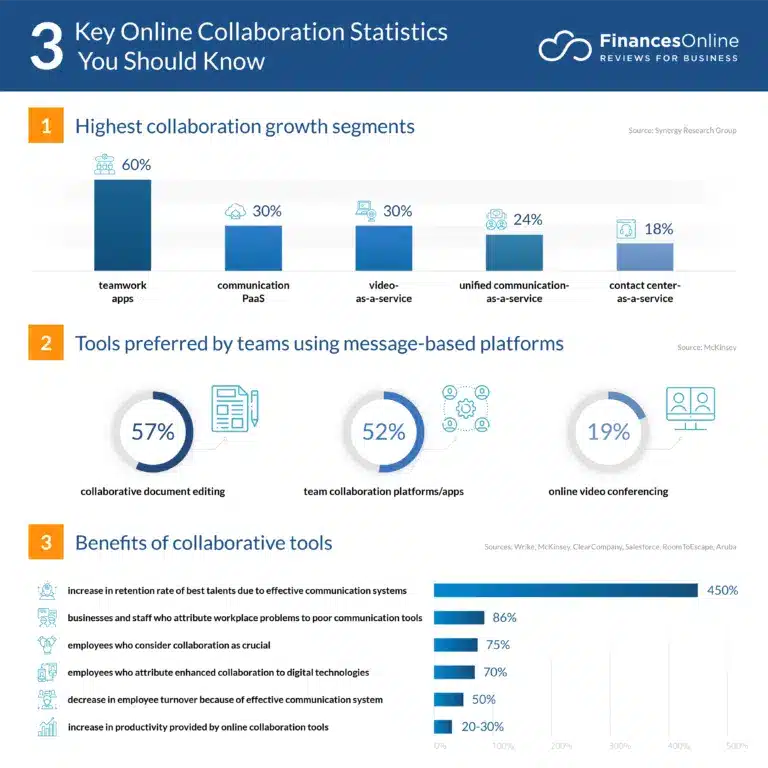
Source: Finance Online
3. AR & VR
Companies are creating their virtual workspaces thanks to the metaverse (virtual world). This allows them to collaborate more effectively.
The metaverse has become an important tool in teamwork and collaboration. It makes workers feel more connected, especially when working on other projects together.
With AR & VR, you can have meetings in virtual workspaces that feel like you are in a face-to-face meeting.
Virtual workspaces mimic the physical ones, allowing employees to share their ideas and collaborate together without feeling the barrier of distance.
However, although the AR & VR world (metaverse) trend is popular, not all companies opt for it. It’s still a matter of debate among such companies.
4. Asynchronous Collaboration
This trend is more popular for remote teams or businesses with hybrid or remote employees.
Your company can adopt an asynchronous mode of operation. This means that your employees can work on a project at different times.
According to Buffer, 52% of employees say they want their companies to have asynchronous policies.
Asynchronous collaboration policies allow employees to work from anywhere at any time. They can also access work tools at their convenience.
Latest Team Building Trends in 2024 and Beyond
Team building is an essential part of effective teamwork and collaboration. However, team building has shifted to become more virtual.
From the statistics above, you will see that virtual team building is here to stay.
Remote jobs are taking over, thus allowing employees to effectively participate in work and projects from anywhere around the world.
1. Hybrid Teams Are Now More Accepted
As the years have passed, people (even businesses) have become more accepting of the changes.
According to Murray Seward, the CEO of Outback Team Building and Training, hybrid work will be more significant in the professional world.
Therefore, organizations will decide whether to adopt virtual vs. fully remote work and adjust accordingly.
To bring out the best in your team, you need to start looking at more hybrid and virtual options. You would also have to consider managing certain challenges from working remotely.
For example, maintaining company culture and values while managing a remote team. Also, building positive relationships with team members.
Working remotely is quite similar to working in isolation. Your hybrid or virtual work model should create ways for effective virtual or hybrid teamwork.
2. More In-person Events To Build Relationships
Team building mode has gradually shifted as more remote jobs are rising. The best way to maintain a strong team connection is for employees to gather more frequently.
This way, they can build a more solid inorganic relationship.
Companies focus on creating more structured singing activities to build a strong company connection among employees.
This means that these activities will be frequent instead of being elected as an annual event. The purpose of this event is to let every team member be a little more involved and interact with others.
3. Greater Use of Technology for Team Building
As virtual team-building activities increase, technology will be used more. Technology has taken things to a new level, and organizations are in to get real production value.
With technology, organizations are engaging more in virtual team-building activities.
For example, virtual games that promote teamwork, like Virtual Escape Room: Jewel Heist.
These games encourage teamwork in creative problem-solving and critical thinking by solving brain-baffling challenges.
4. Cross-Departmental Team Building Is Now More Popular
This is a trend that became prominent in 2023 and will continue to grow in 2024. More companies desired to create more cross-departmental activities.
Instead of only focusing on micro-teams, business executives want to maximize company performance by encouraging cross-departmental interactions.
The purpose of doing this is to maintain company culture, even though most employees will be working remotely.
5. New Strategies for Recruiting and Assessing New Employees
Still, in maintaining company culture, hiring new employees will become quite complex.
Before remote work became so pronounced in the corporate world, hiring workers who understood the company’s values was easy.
Without physically seeing the vital skills when remotely interacting with a job candidate, you may find it difficult to determine whether the person is suitable.
Therefore, employers are taking special care to ensure the more suitable workers match the company’s values.
6. Use of Purposeful Communication
Purposeful communication simply means the ability of every employee to express ideas and information with a clear objective effectively.
Research has shown that purposeful communication ensures employees are 60% more productive.
It is very helpful in fostering a better understanding and achievement of desired outcomes in both personal and professional settings.
There are certain strategies for maintaining purposeful communication, some of which are
- Clear articulation of thoughts and ideas: Here, you have to ensure that your words properly communicate what your intention is, or else you might be easily misunderstood
- Active listening: It is not enough to communicate your ideas and thoughts, you also have to be willing to listen to the ideas and thoughts of others. To achieve this, focus is needed in the workplace.
- Adaptability.
- Attention to non-verbal communication.
- Reflection: This is a task that every wing team member should do. Careful personal reflection goes a long way in ensuring team building.
7. Encouraging Diversity and Inclusion
Diversity and inclusion play a crucial role in team building by fostering a more inclusive and collaborative workspace.
Teams are usually composed of different individuals from diverse backgrounds with varying ideas and insights. This helps to promote innovation and creativity further.
Diversity helps teams to take on complex problems easily because the different individuals come with their unique skills.
It also increases employee engagement by creating a sense of belonging for team members.
This positive team culture facilitates collaboration and strengthens relationships, which ensures team building.
Conclusion
The teamwork statistics in this article show collaborative teamwork’s tremendous effects on an organization.
Each employee understands the importance of teamwork in the workplace. However, communication still has a major effect on your team’s effectiveness.
Suppose you want to stay ahead and boost your team’s performance.
In that case, you must learn to encourage collaboration while acknowledging your employees’ strengths and weaknesses to assign responsibilities and duties appropriately.
Building an efficient team is also very important. With the latest collaboration and team-building trends, you will know what to expect and how to boost your team’s performance.
As these statistics on teamwork demonstrate, this can have a major impact on the business, driving profits and increasing employee engagement and talent retention.

Related posts:
- 47+ Important 4-day Work Week Statistics You Must Know In 2024
- 73 Revealing Workplace Distraction Statistics [2024]
- 50+ Latest Life Coaching Statistics And Huge Trends In 2024
- 40+ Top Workplace Conflict Statistics You Should Know [2024]
- 36 Interesting Social Worker Burnout Statistics for 2024
- 50 Crucial Amazon Advertising Statistics, Trends & Strategies For 2024 And Beyond
- 45+ Important Communication Skills Statistics & Trends For 2024
- 25 Best Emotional Intelligence Statistics To Know In 2024
- 20 Crucial Body Language Statistics To Know (Fun Facts)
- 35 Important Fear of Public Speaking Statistics To Help You In 2024
- 41 Best Copywriting Statistics & Trends to Help You in 2024 And Beyond
- 73 Revealing Workplace Distraction Statistics [2024]
- 47+ Important 4-day Work Week Statistics You Must Know In 2024
- 61+ Podcast Advertising Statistics To Know In 2024
- 110+ Important Social Media Advertising Statistics & Trends To Help You In 2024
- 100 Top Digital Marketing Vs Traditional Marketing Statistics To Know In 2024
- Ultimate List of Sales Funnel Statistics To Help Improve Conversion Rates
- Ultimate List of Virtual Event Statistics And Trends All Marketers Need To Know
- Ultimate List of Multi-Level And Network Marketing Statistics You Need To Know
- Ultimate List of B2B Lead Generation Statistics, Facts, Trends, Benchmarks, And Market Size
- Pay-Per-Click Statistics, Trends & Benchmarks (Amazon, Social, Google & Search Ads Stats)
- 50 Useful Organic Vs Paid Search Statistics To Know In 2024
- 55 Direct Mail Marketing Statistics, Trends, and FAQs For 2024
- 52 Valuable Trade Show Statistics and Trends To Boost Your Business in 2024
- 71 Most Important Workplace Communication Statistics To Know In 2024

